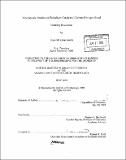| dc.contributor.advisor | Stephen L. Buchwald. | en_US |
| dc.contributor.author | Klingensmith, Liane M. (Liane May) | en_US |
| dc.contributor.other | Massachusetts Institute of Technology. Dept. of Chemistry. | en_US |
| dc.date.accessioned | 2006-03-29T18:49:18Z | |
| dc.date.available | 2006-03-29T18:49:18Z | |
| dc.date.copyright | 2005 | en_US |
| dc.date.issued | 2005 | en_US |
| dc.identifier.uri | http://hdl.handle.net/1721.1/32489 | |
| dc.description | Thesis (S.M.)--Massachusetts Institute of Technology, Dept. of Chemistry, 2005. | en_US |
| dc.description | Vita. | en_US |
| dc.description | Includes bibliographical references (leaves 68-69). | en_US |
| dc.description.abstract | Precatalyst species present in a solution of Pd₂(dba)₃ and Xantphos were identified as Pd(Xantphos)(dba) and Pd(Xantphos)₂ by use of ³¹p NMR and independent syntheses. Pd(Xantphos)₂ was found to form at high ligand concentrations. To determine whether the formation of this species affected reaction rates, reaction calorimetry was used to explore the rate of the palladium-catalyzed coupling of 4-t-butylbromobenzene and morpholine using the ligand Xantphos at varying palladium to ligand ratios. It was found that catalyst activity is dramatically dependent on the concentration of ligand relative to palladium, due to formation of Pd(Xantphos)₂. Two plausible hypotheses for the low activity of Pd(Xantphos)₂ as a precatalyst are (1) a slow rate of dissociation of a ligand from the bis-ligated species, and (2) the high degree of insolubility of Pd(Xantphos)₂. Magnetization transfer experiments were used to probe the rate of dissociation of ligand for the bis-ligated species, and reaction calorimetry experiments were performed using the more soluble t-butylXantphos in comparison to Xantphos to determine whether the insolubility of' Pd(Xantphos)₂ causes it to have relatively low activity. It was found that solubility is not the main cause for the low activity of Pd(Xantphos)₂, and evidence was given to support the hypothesis that low activity results from the slow dissociation of a ligand from the bis-ligated species. | en_US |
| dc.description.statementofresponsibility | by Liane M. Klingensmith. | en_US |
| dc.format.extent | 69, [1] leaves | en_US |
| dc.format.extent | 2544375 bytes | |
| dc.format.extent | 2546826 bytes | |
| dc.format.mimetype | application/pdf | |
| dc.format.mimetype | application/pdf | |
| dc.language.iso | eng | en_US |
| dc.publisher | Massachusetts Institute of Technology | en_US |
| dc.rights | M.I.T. theses are protected by copyright. They may be viewed from this source for any purpose, but reproduction or distribution in any format is prohibited without written permission. See provided URL for inquiries about permission. | en_US |
| dc.rights.uri | http://dspace.mit.edu/handle/1721.1/7582 | |
| dc.subject | Chemistry. | en_US |
| dc.title | Mechanistic studies on palladium-catalyzed carbon-nitrogen bond forming reactions | en_US |
| dc.type | Thesis | en_US |
| dc.description.degree | S.M. | en_US |
| dc.contributor.department | Massachusetts Institute of Technology. Department of Chemistry | |
| dc.identifier.oclc | 61858017 | en_US |
